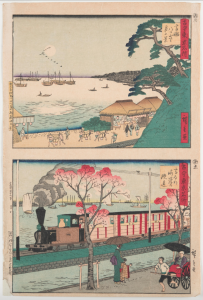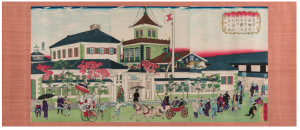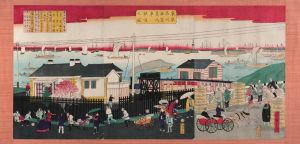New Technology and Architecture
After 1853, when Commodore Matthew C. Perry’s ships broke the horizon of Tokyo Bay, the expansion of Western influence was seen through the incorporation of modern technology and architecture in Japanese civilization. This breach of Japanese isolationism signified the opening of Japan to the West, and Japan went through a rapid period of “modernization” during the Meiji Period (1868-1912). This time brought growth in the political, economic, and social spheres of Japan. Utagawa Hiroshige III was born in 1842 and died in 1894. Through the eyes of a man who lived through this period, the following woodblock prints display the development of Japanese society coexisting with the increasingly influential Western world.

In the first painting (right), Hiroshige III drew a before and after painting of Shinagawa, illustrating which depicted how modernization changed society. Depicted in the scene before modernization is a beautiful view of the ocean. Birds flying in V-formation could be seen as well as the sun. There are many ships in the ocean with shops opened up along the shoreline. Before modernization, it seems that there were a lot of interactions between people where people were working together. It seems that people are in these shops talking to each other and people are carrying the palanquin with an upper-class member inside of it. However, once modernization spread through the area, there was more isolation. As seen with the people on the train, there is no interaction amongst people. Class distinction is shown in both paintings but are portrayed differently. Through modernization, the upper class were able to afford faster means of transportation. They have upgraded from palanquins to trains and rickshaws. Although modernization was sweeping the nation, the artist depicts how the traditional customs and manners continued to exist during this time. In the painting of the “after.” Everyone is still wearing traditional Japanese clothes. This shows that modernization was a gradual process but that Western and Eastern cultures had blended together.
As shown in the works of Hiroshige III, red is a recurring color throughout the paintings. In woodblock paintings, red was often used to highlight particular places the author wanted to accentuate. The color red holds a positive connotation in Japanese society. It symbolizes happiness and success. When comparing the before and after pictures, red is only used in the painting showing modernization. The artist thought of modernization as a beneficial step forward for Japan. He believed that the advent of Western technology and architecture would further the success of Japan.

The print entitled “New building of No. 5 National Bank and Trading Co.” also showcases the western influence on Japanese culture and architecture coexisting with the traditional aspects of Japan. The most prominent feature of the print is the large building spanning almost the whole length of the print. In the image, a stylized character for five (五) is shown above the building entrance and on a flag, marking the structure as “No. 5 National Bank and Trading Co,” the name found in the piece’s title. However, what stands out in the piece’s description the most, is the word “new.” In the left corner of the print, an unfinished wooden structure can be seen, partially hidden by the bank’s roof. Because of the details indicating that this is a recently constructed edifice, the architecture might be considered especially representative of the time period. The fact that the building appears to contain elements of both western and Japanese architecture alludes to the coexistence of the two cultures in nineteenth century Japan—with neither culture dominating the other. This aspect can also be found in the clothing in the print. There is a blend of Japanese and western clothing, with some wearing all Japanese pieces, and others wearing garments of both cultures.

The final print, titled “Pictures of Tokyo Shinagawa Coastal Steam Locomotive” reflects a deliberate combination of Eastern and Western cultural elements and continues Hiroshige III’s theme of incorporating red. The bright red in the sunset may be an artistic preference as well as a symbol for how the modernization of Japan was positive in the artist’s eyes. As mentioned before, red represents success and joy. Also, in this print, the red draws focus to the background of the print, where large ships and lighthouses are present as opposed to the front, where there are mostly telegraph wires, a train, houses, and people. When looking closely at this print, it is evident that there is a contrast between the Eastern and Western people as well. There are some foreigners wearing Western clothes but there are also many Japanese dressed in both traditional Japanese clothes and Western clothes, as seen by the Japanese on the horse-drawn carriage. The artist includes other style choices, such as umbrellas, in this location. In the foreground, it also seems that for each Western invention, there is a Japanese one. For example, there is one horse-drawn carriage, a Western innovation, yet there are also Japanese rickshaws present right beside them. Rickshaws were also considered modern at this time. The artist is purposefully showing that Westernization didn’t happen overnight. Moreover, the artist’s balance of Eastern and Western objects forms the opinion that, despite Western presence, Japanese culture persisted. Here they coexist and it is unclear which inventions are considered “modern” or “Western” as both foreigners and the Japanese are using a variety of inventions. This, therefore, raises questions: What is the most civilized country? And could their coexistence lead to a greater society?
Rachelle Cha (‘23), Shrusti Goswami (‘22), Raj Malhotra (‘22), Caitlin Moy (‘23)